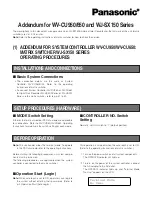
40
SERVSWITCH™ AND SERVSWITCH ULTRA™
Table 4-4. The ServSwitch’s Keyboard Commands (continued)
Causes the ServSwitch Ultra (or ServSwitch with
Overlay Option Board installed) to display its
“computer select window” (see
Section 5.5
).
[CTRL] [ESC]
Activate Select
Window
Causes the ServSwitch Ultra (or ServSwitch with
Overlay Option Board installed) to display its on-
screen overlay menus.
[CTRL] [F12]
Activate On-
Screen Menus
Causes the ServSwitch Ultra (or ServSwitch with
Overlay Option Board installed) to display the on-
screen computer label of the currently selected
CPU for the currently configured fadeout time (or
for three seconds if fadeout is disabled).
[CTRL] D
Display Label
Causes the ServSwitch to send the scan code for
the [Stop] character (the only widely used non-
mapped key on the Sun keyboard) to the
currently selected CPU.
[CTRL] [Pause]
Send [Stop]
Causes the ServSwitch to report the version of
ROM it is using. Issue this command if you are
asked to do so by a technical-support person.
[CTRL] I
Identify ROM
Causes the ServSwitch to send a null byte to the
CPU’s PS/2 mouse port. Issue this command to
correct the current CPU if it gets “out of sync” with
the PS/2 mouse (see
Section 4.3.14
).
[CTRL] N
Send Null Byte
Resets and enables the keyboard and mouse.
Issue this command to correct your keyboard or
mouse if one of them malfunctions or gets stuck.
[CTRL] R
Reset
Causes the Switch to logically “swap” the
mappings of the command or start keys and the
adjacent alt/alt graph keys (see
Section 4.3.12
).
[CTRL] B
Transpose
Command and
Alt Keys
IBM/multiplatform only:
Sets the keyboard
typematic (automatic key-repeat) function of the
currently selected CPU. This command works
only with IBM PC type CPUs that have standard
keyboards and CMOS that allows users to
program the typematic function.
[CTRL] A
xxx
[ENTER]
(
xxx
= a decimal value
from 0 to 127)
Set Keyboard
Typematic
Description
Keystroke Sequence
Command
















































